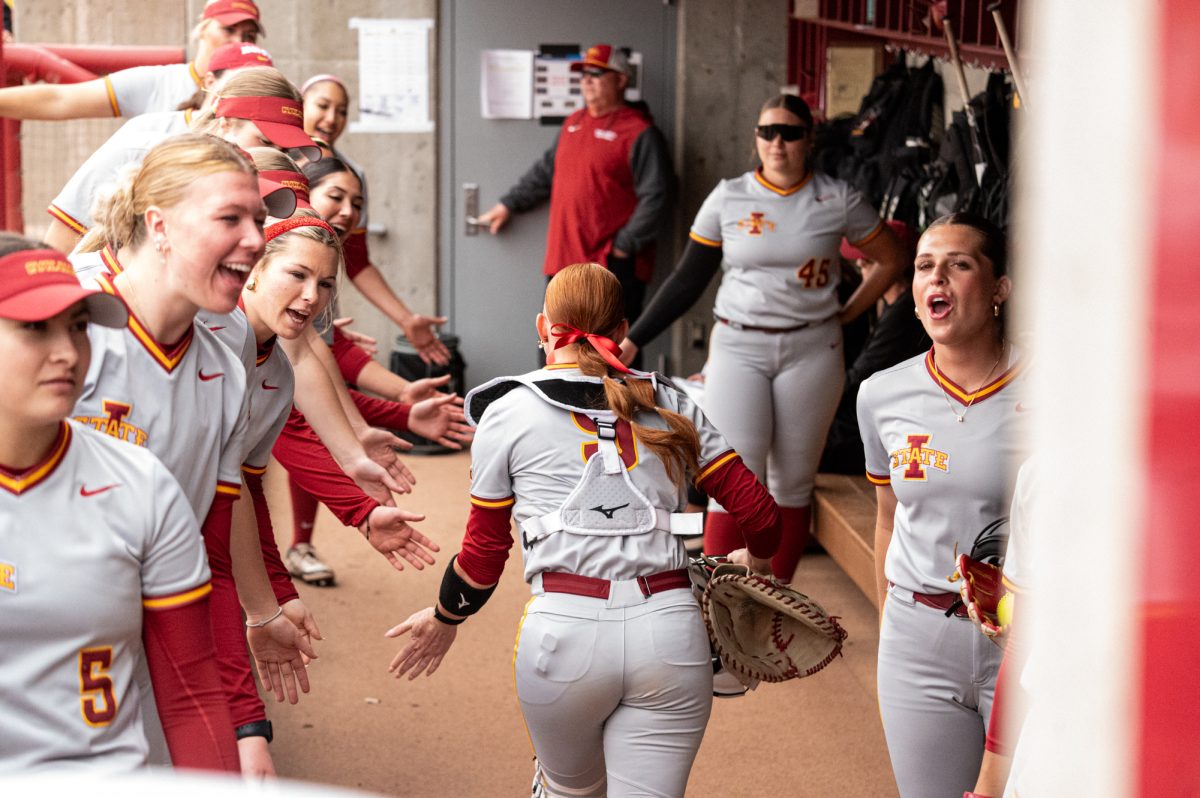Research explores bioplastic for crop containers
Nur Surya Abu/Iowa State Daily
James Schrader and Kenneth McCabe, researchers for the 5-year program in development of bioplastics, hold samples of bioplastic pots being tested at Horticulture Hall.
October 16, 2013
A research program to better the environment and create a more sustainable use for crop containers is underway at Iowa State.
The program is being used to study sustainable bioplastic containers for crops and plants to be sold in for commercial uses to consumers. This program is in its third year of a five year study.
The main purpose of the program is to make container crops horticulture more sustainable.
The containers give off a fertilizer affect while the crops or plants are growing. As the crop or plant grows inside the container, the container loses coloring on the outside due to the crop or plant taking away the fertilizer and nutrients. The container also then begin to degrade.
Most containers are made from petroleum plastic that are not degradable. James Schrader, an assistant scientist in horticulture, said all of the containers being tested are more sustainable than the petroleum plastic because they are biodegradable.
“There is the container crop industry that uses about 800,000 tons of plastic every year and most all of that goes into landfill,” Schrader said. “Either the customer throws it there or the growers if they have plants they were unable to sell. The don’t reuse those containers.”
Schrader said it is possible to recycle the petroleum plastic, but just about no one does, so the plastic ends up in landfills. One reason consumers are not recycling the plastic is because it is dirty from the crop or plant, Schrader said.
“Our idea is that the producer would grow the plant in this container, the consumer would buy it and when they go to put their plant in the ground they would take the plant out and break this [container] into pieces and put that in the hole [with the plant] so it can degrade in the soil while the plant grows,” Schrader said.
The containers have proteins made in with the bioplastic, are used as a fertilizer for the crop or plant. The fertilizer is used both when the crop or plant is growing in the greenhouse and while the crop or plant is growing in the ground according to Schrader.
The bioplastic program is a multidiscipline and multi-institutional program with three other universities working with ISU on the program. Material science and agricultural biosystem engineering are two disciplines on Iowa State’s campus working with the program.
Those two other areas are responsible for blending the materials and making the containers. The containers are then brought to the Horticulture Hall on campus for testing with crops and plants. Testing is also done at the Horticulture Station in Gilbert, Iowa.
The bioplastic program has eliminated a variety of materials that are not suitable for the sustainability of the bioplastics containers already. The programs started with 32 possible bioplastic materials and now are studying the remaining 15 materials.
Improvements are being made to have an end result of five final materials that will be produced by industry machines and will then be sent out to be tested by companies in the agriculture industry.
The materials that have been tested most frequently in the containers is a mixture of soy and poly lactic acid is performing the best with the crop or plant growth.
Each container’s materials cost about 12 cents Schrader said. Petroleum plastic containers cost about 9 cents each.
The materials are compounded by ISU employees and then shipped to Kansas City for molding and returned to Iowa State for research.
Kenneth McCabe, graduate student in horticulture, is another member of the research team, and the program is led by William Graves, professor of horticulture and associate dean for the Graduate College.
The plants most focused on in the program in the greenhouses are mainly short-lived plants that can grow in smaller containers. The program has grown marigolds, tomatoes, peppers and petunias among other crops and plants, McCabe said.
“We usually cut them [crops or plants after growth] and harvest them and dry them down for dry weights so we can see what plant materials are produced,” McCabe said. “Some we actually take out to the horticulture research farm in Gilbert and use them for landscape trials.”
One issue with the program involving the containers is mold growth on the inside. However, the growing of mold is a rare problem the researchers face.
For the research, the team received a $1.94 million grant from the U.S. Department of Agriculture.







